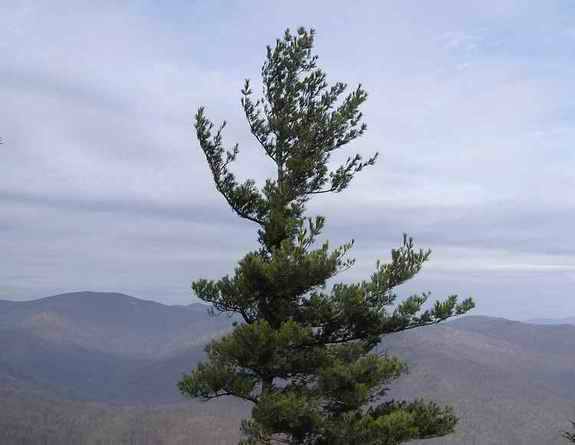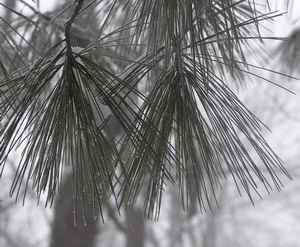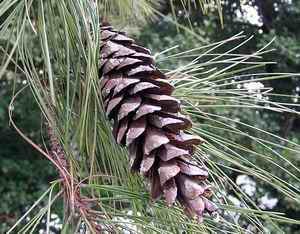|
Return to Hiker's Notebook Home Page
Common Name: White Pine, Eastern White Pine, Northern White Pine, Northern Pine, Soft Pine, Tree of Great Peace (Haudenosaunee Indians), Weymouth Pine, Pin blanc (Quebec), Weymouth's Kiefer (German)
Scientific Name: Pinus strobus � The generic name
is from the Greek pitys which means pine or fir tree; originally from
the Sanskrit pituh meaning sap or resin. Pitys was a nymph in Greek
mythology who chose Pan, the god of the forest over Boreas, the god of the
north wind. In his anger at having been bested, Boreas killed Pitys by
blowing her against a rocky cliff; in pity, the earth goddess Gaea transformed
Pitys into the pine tree. Strobus is from the Latin strobilus,
meaning pine cone. Also known as Strobus strobus.
The White Pine is the only conifer native to eastern North America with five needles in each cluster. This imparts to it a soft, feathery appearance. It is the largest conifer in its range which extends south from Canada along the Appalachians to northern Georgia. Growing to heights of over 100 feet, it is readily identified by its characteristic asymmetric appearance with branches absent on the lower two thirds of the tree. At the dawn of the colonial era, White Pine grew in dense stands of much taller and older trees.
The tall, straight, nearly branchless trunks of the White Pine made them ideally suited to their use as masts and spars for naval vessels. In 1605, Captain George Weymouth sailed from England on the Archangel to survey the North American coast for colonization. Noting the potential value of the White Pine as a strategic material, he took seeds and mastwood samples back to England. Given the eponym Weymouth Pine in recognition of the perspicacity of its namesake, the White Pine impressed the British Naval Board. However, it did not propagate in the climate of the British Isles and the admiralty was ultimately forced to rely on the American colonies for White Pine masts. This was especially true since the blockade of Russia and Sweden by Britain's rival Denmark made the alternative Scotch pine masts unavailable.
The White Pine eventually became one of the mainstays of the economy of New England; the first sawmill was opened in York, Maine in 1623 and 24 were in operation by 1682. Though a part of Massachusetts at that time, Maine became �The Pine Tree State" in 1820, and adopted the White Pine as the state tree in 1959. Large White Pines for masts sold for as much as 100 pounds apiece. Smaller trees were used to make everything from cribs to coffins; the wood is easily worked, lightweight, even-textured and the least resinous of all the pines. White Pine has probably had a greater impact on the economy of the United States than any other tree. It was a key commodity of the lucrative trade triangle of the American colonies: White Pine and rum to England for ships, Slaves from West Africa in English ships to the West Indies, sugar and molasses back to New England for rum and pine. . Massachusetts had pine tree coinage from 1667 to 1682. The White Pine was depicted on the first New England flag in 1686, red with a cross of Saint George in the canton, a pine tree in one of the quadrants.
The mercantilism of the 18th Century resulted in a boom in naval construction and a concomitant shortage of ship masts in Europe. To ensure the availability of the White Pine in North America, the British King implemented the so-called Broad Arrow Policy; trees 24 inches or more in diameter within three miles of water were marked with a blaze known as the "Mark of the Broad Arrow" and were called the "King's Pine." The policy was first implemented in Maine in 1691 and then more broadly to the rest of the colonies in the 1750's. John Wentworth, the Royal Governor of New Hampshire, was appointed "Surveyor General of His Majesty's Woods in America" with the authority to claim any tree for the Crown. By 1761, the restrictions on harvesting the White Pine were extended to all new land grants, an edict that, like the Stamp and Townsend Acts, exacerbated the increasing tension between England the her American colonies. In 1774, White Pine lumber shipments to England were embargoed, and in 1775, the American rebels at Breeds Hill hoisted a red flag with a green pine tree emblem on the white canton.
The White Pine figures prominently in the history and legend of Native Americans; the Haudenosaunee Indians considered it to be their tree of peace. The Haudenosaunee have historically been called the Iroquois, a pejorative name given to them by the French as a derivative of iriakhoiw, which means "black snakes" in the language of the rival Huron tribe. The White Pine was chosen as the tree of peace to symbolize the union of the five tribes of the Haudenosaunee Confederacy: Cayuga, Mohawk, Oneida, Onodaga, and Seneca; the five needles of the white pine providing the symbolism for their union of the five tribes into one Indian nation.
The union of the Haudenosaunee tribes that put an end to centuries of warfare was conceived by Deganawidah, the Peacemaker, and implemented by Hiawatha. The polity established to govern the Indians in about 1570 ostensibly serves as the oldest constitutional government still in operation. Drawing on the leitmotif of the White Pine, their weapons were buried under its roots (from which the idiom bury the hatchet may derive), a circle of the chiefs gathered around to make it strong, and an eagle sat at its crest to warn of danger. There is a credible theory that the White Pine symbolism influenced the new nation of the United States of America in the guise of the liberty tree, the eagle and the bundle of thirteen (vice five) arrows in one talon.
The White Pine was used in medicinal applications by several North American Indian tribes. The dried inner bark of the White Pine contains a glycoside, an oleoresin, a volatile oil, mucilage and tannin. Brewed as a diuretic and expectorant tea, it was used to treat diseases of the mucous membranes and respiratory problems such as colds, coughs and sore throats. White Pine bark powder and White Pine bark tea are still sold commercially for this purpose. As a poultice, the inner bark was used to treat skin complaints including wounds, burns and boils.
Native Americans also reportedly used the inner bark of the White Pine as an emergency food source. It has since been used as a thickener in soups and as an additive for bread dough. The needles were brewed into a tea rich in vitamin A and containing more than five times the amount of vitamin C found in an equal weight of lemon. A resin can be extracted from tender new shoots of White Pine that can be made into a candy or processed to make a vanilla flavoring. The seeds and cones can also be used as a flavoring. The White pine is also an important food source for other mammals: squirrels, chipmunks and field mice eat the seeds, porcupines eat the inner bark, and white-tailed deer eat the twigs. It is one of the favorite climbing trees of black bear cubs.
|


 White
Pines produce distinctive slender cones that are 3 to 10 inches long
characterized by white-tipped scales. Male flowers open to spread pollen to
the female cones in early spring. However, the female cones do not become
fertilized until about 13 months after pollination. The delay between
pollination and fertilization is characteristic of pines, as other conifers
have an interval of only a few weeks. This seed production delay may serve to
promote proliferation of the pine in extending to the next season when
conditions for growth may be more favorable. Seed cone production is
characterized by masting; large numbers are produced every 3 to 5 years to
ensure some seeds escape predation for propagation.
White
Pines produce distinctive slender cones that are 3 to 10 inches long
characterized by white-tipped scales. Male flowers open to spread pollen to
the female cones in early spring. However, the female cones do not become
fertilized until about 13 months after pollination. The delay between
pollination and fertilization is characteristic of pines, as other conifers
have an interval of only a few weeks. This seed production delay may serve to
promote proliferation of the pine in extending to the next season when
conditions for growth may be more favorable. Seed cone production is
characterized by masting; large numbers are produced every 3 to 5 years to
ensure some seeds escape predation for propagation.